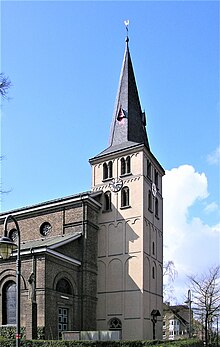St. Stephanus (Lank-Latum)
St. Stephanus is the Roman Catholic parish church of Lank-Latum , a district of the city of Meerbusch in the Rhine district of Neuss .
history
The first written mention of a pastor in Lank comes from the year 1176, a church was mentioned for the first time in 1202, it was built on the ground of the Lank Fronhof of the Kaiserswerth monastery . In 1408 there was a dispute with the Lanker parish and the Kaiserswerther chapter about the construction of the church.
The church was rebuilt and expanded several times. In fires caused by raids by the Hessian troops in the wake of the battle on the Kempen Heide in 1642 and 1645, the stone building was completely destroyed and could only be rebuilt on a more modest scale from 1662 onwards. In 1770 changes were made to the windows and roof. The bell, cast in 1647, had to be replaced in 1780 because it had cracked. Today's three-aisled basilica with a rose ceiling was built by the Krefeld city architect Johann Heinrich Freyse from 1841 to 1844. The orientation of the church was also changed. While it was originally built in an east-west direction, since the renovations it has stood in a north-south direction.
Of the Romanesque building of the church, only the tower remains today. The art historian Paul Clemen calls it "one of the most stately of its kind". The tower has six stories and is slightly tapered. The second and third storey show three continuous round-arched panels on each side , the fourth three with two round arches each , the fifth and sixth two panels with round-arch frieze. The second bell storey and the Gothic slate pyramid were added later.
Since January 1st, 2010 the St. Stephen's Church has been the parish church of the newly established parish of Hildegundis von Meer. The parish unites the parishes of the former deanery Meerbusch in the diocese of Aachen .
Furnishing
organ
The church has an organ with 30 registers divided into two manuals and a pedal . The action is electro-pneumatic (cone store).
The organ in its present form was built in 1883 by the Edmund Fabritius company from Kaiserswerth ; the prospectus was designed by a sculptor from Krefeld. Almost 20% of the pipes were taken from the baroque organ from the 18th century, which had stood in the previous church. In 1938 the organ was expanded by Fabritius and the layout partially changed. Restorations were carried out in 1983, 2004 and 2012 by the Weimbs company from Hellenthal.
The arrangement of the organ is as follows:
| pedal | Main work | Swell | |||||
|---|---|---|---|---|---|---|---|
| 1. Principal bass 16 ' | 11. Principal 8 ' | 24.Quintade 16 ' | |||||
| 2nd sub-bass 16 ' | 12. Bordun 8 ' | 25. Salicional 8 ' | |||||
| 3rd octave bass 8 ' | 13. Gamba 8 ' | 26. Wooden flute 8 ' | |||||
| 4. Covered bass 8 ' | 14. Tender flute 8 ' | 27. Gedackt 8 ' | |||||
| 5th choral bass 4 ' | 15th octave 4 ' | 28. Vox celestis 8 ' | |||||
| 6. Rauschpfeife 2 2/3 ' | 16. Flute 4 ' | 29. Principal 4 ' | |||||
| 7th trumpet 16 ' | 17. Nasard 2 2/3 ' | 30. Gemshorn 4 ' | |||||
| 8th trumpet 8 ' | 18th octave 2 ' | 31. Forest flute 2 ' | |||||
| 9. IP | 19. Mixture 4f. 2 ' | 32nd fifth 1 1/3 ' | |||||
| 10. II-P | 20. Cymbal 3f. 1' | 33. Mixture 4f. 1 1/3 ' | |||||
| 21st trumpet 8 ' | 34. Oboe 8 ' | ||||||
| 22. II-I | 35. Tremulant | ||||||
| 23. Super II-I |
Further playing aids: Koppel Sub-I; Crescendo roller
literature
- Paul Clemen (ed.): The art monuments of the cities and districts of Gladbach and Krefeld (= The art monuments of the Rhine province . Vol. 3, 4). Schwann, Düsseldorf 1896, p. 132 .
- Georg Dehio : Handbook of the German art monuments . North Rhine-Westphalia. I Rhineland. Deutscher Kunst-Verlag, Munich et al. 2005, ISBN 3-422-03093-X .
- Peter Dohms (Ed.): Meerbusch. The history of the city and the old communities. From the origins to the present. City of Meerbusch, Meerbusch 1991.
Individual evidence
- ↑ Walter Rau (Ed.): Office Lank. Walter Rau, Düsseldorf 1970, p. 50.
- ↑ Peter Dohms: Meerbusch. 1991, p. 141.
- ^ A b Paul Clemen (Ed.): The art monuments of the cities and districts of Gladbach and Krefeld. 1896, p. 132.
- ^ " Heimatbuch Lank-Latum". Local history study group Lank, Meerbusch 1975, p. 55.
- ↑ Addo Winkels: History and stories about the organs - people - whistle - coasts and organists at and in the parish church of Sancti Stephani too long . sn, Lank 1983, p. 37 .
Coordinates: 51 ° 18 ′ 6.5 ″ N , 6 ° 40 ′ 52.1 ″ E
